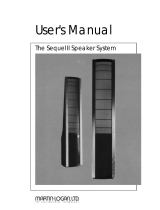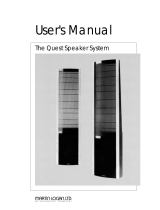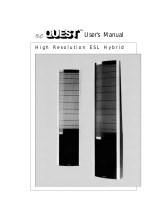Page is loading ...

User Manual
daytonaudio.com
Model: B652
Model: B652
Description: 2-way general purpose
Finish: Black Ebony Pica vinyl on particle board
Power: Use with 5 – 40 watt equipment
Impedance: 6 ohms
Response: 70 Hz to 20 kHz
Sensitivity: 87 dB 1W-1M
Woofer: 6-1/2” polypropylene cone
Tweeter: 5/8” polycarbonate w/Ferrofluid
Crossover: First order high-pass
Terminals: Quick Connect
Other: Hang-up hook
Size
Height: 11-13/16 inches (300 mm)
Width: 7-1/16 inches (180 mm)
Depth: 6-7/16 inches (163 mm)
Depth includes grille
* Grill is removable, non-see-through cloth
SPECIFICATIONS:

B652-09 © 2012 Dayton Audio
®
Warranty Information
Dayton Audio
®
products are constructed by industry experts, and are thoroughly tested before
shipment. Dayton Audio
®
products are warranted for the period of one year. This warranty is limited
to manufacturer defects, either in materials or workmanship. Dayton Audio
®
is not responsible for any
consequential on inconsequential damage to any other unit or component or the cost for installation
or extraction of any component of the audio system. In the rare case of a product failure, please
contact your place of purchase or call our Customer Support Department at (937) 743-8248.
Warranty Limitations
There are no other warranties, either express or implied, which extend the foregoing, and there are
no warranties of merchantability or fitness for any particular purpose. The warranty will not cover
incidental or consequential damage due to defective or improper use of products. This includes but is
not limited to burnt voice coils, overheating, bent frames, holes in the cone, or broken lead wires.
This warranty gives you specific legal rights and you may also have other rights which vary from
state to state.
Non-Warranty Service: If non-warranty service is required, the product may be sent to the
Company for repair/replacement, transportation prepaid, by calling (937) 743-8248 for details,
complete instructions, and service fee charges.
Thank you for choosing Dayton Audio. Dayton Audio loudspeakers are designed to provide exceptional performance and maximum value.
Please read on to discover how to get the most from your new speakers.
CONNECTING YOUR LOUDSPEAKERS: Use good quality wire for the connection between your Dayton Audio loudspeakers and the amplifier.
For distances up to 10 feet, conventional “speaker wire” or lamp cord is acceptable. For longer runs, heavier wire should be used. For proper
performance the speakers must be “phased” correctly. To insure proper phasing, connect the red speaker terminals to the red amplifier terminals
and the black speaker terminals to the black amplifier terminals. All two-conductor wire is marked in some way to help you do this. One side will
be marked with a colored stripe, a raised rib, or a different colored conductor. Use the marked side for the “red” connections.
ROOM PLACEMENT: Because of their well-behaved off-axis response and excellent dispersion, your new Dayton Audio speakers are less
critical to position than most loudspeakers. Often, simply placing them where they best fit into the decorating scheme is all that is necessary for
exceptional performance.
If you are inclined to go through a more rigorous positioning exercise, the following paragraphs will help you achieve all the performance that
your system is capable of.
Carefully select a few recordings. Choose recordings made with simple miking and strong vocals by a single performer. Avoid recordings with
piano accompaniment unless you know that the recording microphones were at least 15-20 feet from the piano. The reason for this precaution
is that the piano is a large instrument, and is often recorded with multiple microphones placed close to it. The notes arrive at the microphones
from different directions and the speakers will reproduce the directional clues confusing the positioning process. Physically small sound sources
localize much more precisely. Horns, strings, vocals, and drums snap into place with the loudspeakers are optimally positioned.
Start with the speakers directly in front of your primary listening position. Avoid hard vertical edges within 3 or 4 feet of either side of the cabinet.
Position the cabinets about 1-2 feet out from the wall. Listen to one of the selected recordings paying close attention to the positions of the
instruments and vocalist. Move the speakers a few inches at a time, returning to the listening position to evaluate the results. Once placement is
optimized, the vocalist will be firmly positioned in front of the instruments and the instruments will seem to be between or behind the loudspeak-
ers. During the design of most Dayton Audio speakers’ performance is optimized for listener location 10-12 feet in front of the tweeter. If pos-
sible, position your speakers to that when you are seated in the primary listening position your ears are 10-12 feet from the tweeter. Viewed from
your seat, the angle between the speakers should be 30 to 60 degrees. Pay special attention to the bass. The relation between bass response
and room position is critical. Tightly localized high and low pressure spots result from reflections off the room boundaries. Moving one or both of
the loudspeakers just a few inches will rearrange thousands of hot and dead spots all over the room. The secret to proper positioning is to keep
the wort of these spots from falling on the primary listening position. Position the speakers so that the bass levels are in proper perspective to
the rest of the musical spectrum. Listen to several recordings to that you hear bass from a variety of instruments. The most common positioning
error involves getting the bass level right for one note, but not for others.
Loudspeaker positioning can be time consuming, but the rewards justify the effort.
CABINET CARE: The finish of your speakers can be maintained and enhanced by periodic use of a surface protection such as “ArmorAll”. The
grilles may be vacuumed or gently tapped or brushed to remove dust and debris.
POWER RATINGS: Almost any speaker can be used successfully with almost any amplifier. Conversely, almost any speaker can be damaged
by almost any amplifier-despite either unit’s power rating. The power recommendations that we publish are accurate only if our assumptions
concerning the amplifier, the type of music, and the conditions of use are correct. Most importantly we assume that the volume never is set
above the point of distortion. Distortion is an indication that the amplifier or loudspeaker is operating beyond its design limits. If you hear distor-
tion, immediately reduce the volume. Damage can occur within seconds. Do not ignore distortion just because the volume control is not all the
way up. A common misconception exists that amplifier power is proportional to the setting of the volume control with maximum setting neces-
sary for full power output. This is rarely the case. Most amplifiers deliver full power when the volume control is set somewhere in the middle of
its range. Use of loudness, bass boost, treble boost, or an equalizer can produce full output at even lower knob settings. Distortion is the only
clue that damage is imminent.
Dayton Audio loudspeakers are designed to reproduce music and speech in a home environment at moderate volume levels. When used within
their limits Dayton Audio loudspeakers will provide many years of trouble free performance.
/








